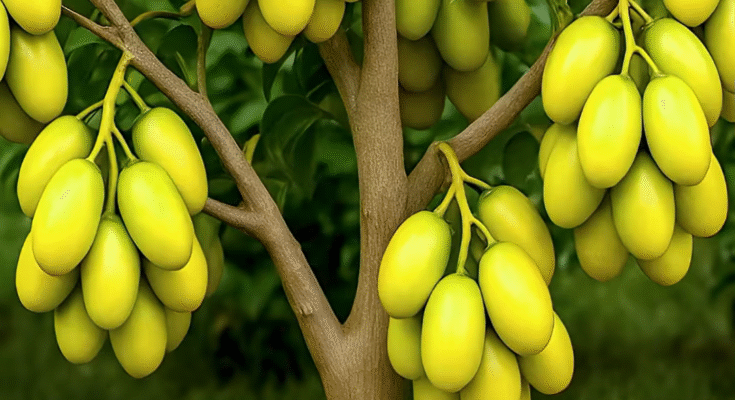Easy Techniques for Growing and Propagating Ambarella Fruit Trees – Amra Fruit
The ambarella fruit tree (Spondias dulcis), also known as amra, golden apple, or June plum, is a tropical delight loved for its crisp texture, tangy-sweet flavor, and nutritional value. Native to the South Pacific and now grown widely across Asia, the Caribbean, and Africa, this hardy tree can thrive with minimal care—making it an excellent choice for home gardeners. If you’ve ever enjoyed its refreshing fruit and wished to grow your own, you’ll be glad to know that growing and propagating ambarella is surprisingly easy.
Below are simple, proven techniques to help you successfully plant, nurture, and multiply ambarella trees in your backyard or farm.
1. Understanding the Ambarella Tree
Before you start planting, it’s important to understand what makes the ambarella tree unique:
- Climate: It grows best in warm, tropical to subtropical climates with temperatures between 20°C and 35°C (68°F–95°F).
- Size: A mature tree can reach 10–15 meters in height, though it can be pruned to stay shorter for easier harvesting.
- Fruit: Oval-shaped, green when young, turning golden-yellow when ripe, with a fibrous seed in the center.
- Growth rate: Ambarella trees grow quickly and can bear fruit within 3–4 years from planting.
Knowing its growth habits will help you provide the right conditions for maximum fruit production.
2. Choosing the Right Location
Location is key to healthy ambarella growth:
- Sunlight: Choose a sunny spot with at least 6–8 hours of direct sunlight daily.
- Soil: Ambarella prefers well-draining loamy or sandy soil, but it can adapt to various soil types. Avoid waterlogged areas as the roots dislike standing water.
- Space: Plant each tree at least 5–6 meters apart to give enough room for the canopy to spread.
A well-chosen planting site will reduce the risk of pests, diseases, and poor yields.
3. Easy Propagation Methods
Ambarella trees can be propagated from seeds or cuttings. Both are simple, but each has its advantages.
a) Growing from Seeds
Step-by-step:
- Collect healthy seeds from fully ripe fruits. Remove the pulp and wash the seed to prevent rotting.
- Dry the seeds in a shaded area for 24–48 hours.
- Prepare a seedbed or pots filled with well-draining soil mixed with compost.
- Plant the seed about 2–3 cm deep. Water gently but regularly to keep the soil moist.
- Transplant seedlings to their permanent location when they are 20–30 cm tall (around 3–4 months old).
Advantages: Seed-grown trees are hardy and develop strong root systems. However, they may take slightly longer to bear fruit and might show variation in fruit quality.
b) Growing from Stem Cuttings
This method is faster and ensures the new tree has the same fruit quality as the parent tree.
Step-by-step:
- Select a healthy branch (1.5–2 cm thick and about 30–50 cm long) from a mature, productive ambarella tree.
- Remove leaves from the lower half of the cutting.
- Dip the base of the cutting in rooting hormone to encourage faster root growth (optional but recommended).
- Plant the cutting in a pot or directly in the ground, ensuring at least 15 cm is buried in the soil.
- Water regularly and keep the area slightly shaded until new leaves appear, indicating rooting success.
Advantages: Faster fruiting (within 2–3 years), identical fruit quality, and easier management.
4. Planting and Early Care
Once your seedlings or rooted cuttings are ready, follow these tips for successful planting:
- Dig a hole about 40–50 cm wide and deep.
- Mix compost or well-rotted manure into the soil before planting to boost nutrition.
- Plant the tree at the same depth it was growing in the nursery pot or seedbed.
- Firm the soil gently around the roots and water thoroughly.
For the first few weeks, water every 2–3 days to help the roots establish.
5. Ongoing Care and Maintenance
Ambarella trees are low-maintenance, but a little attention will help them thrive and produce abundant fruit.
Watering
- Water young trees regularly, especially during dry seasons. Mature trees can tolerate short droughts but benefit from occasional deep watering.
Fertilizing
- Apply compost or organic fertilizer 2–3 times a year, especially before flowering and fruiting seasons.
- A balanced NPK fertilizer (10-10-10) works well for enhancing both growth and yield.
Pruning
- Prune annually to remove dead, diseased, or crossing branches.
- Shape the canopy to improve sunlight penetration and make harvesting easier.
Pest and Disease Control
- Common pests include fruit flies, scales, and mealybugs. Use organic sprays like neem oil to control them.
- Keep the base of the tree weed-free to reduce pest hiding spots.
6. Harvesting and Post-Harvest Care
Ambarella fruits are ready to harvest when they turn from green to golden yellow, usually 4–6 months after flowering.
- For fresh eating: Pick when fully ripe for a sweet-tangy flavor.
- For pickling or cooking: Harvest while still green and firm.
- Store ripe fruits in a cool, dry place. They can be kept in the refrigerator for up to two weeks.
7. Tips for Higher Yields
- Plant at least two trees to encourage cross-pollination and increase fruit set.
- Mulch around the base to retain soil moisture and reduce weeds.
- Protect flowers from heavy rain or strong winds during blooming season.
Conclusion
Growing and propagating ambarella fruit trees is an enjoyable and rewarding experience for gardeners of all skill levels. Whether you choose to start from seed or take cuttings from a healthy tree, the process is straightforward. With the right location, basic care, and a little patience, you’ll be rewarded with delicious, tangy-sweet amra fruits year after year.
By following these easy techniques, you’ll not only enjoy fresh homegrown fruit but also have the satisfaction of cultivating a tree that can last for decades. The ambarella’s adaptability, rapid growth, and high nutritional value make it an excellent addition to any tropical or subtropical garden.



